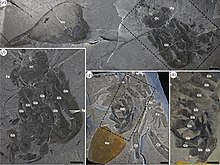Hurdia
| Hurdia Temporal range: Mid Cambrian,
| |
|---|---|

| |
| Reconstruction of H. victoria (top) and H. triangulata | |

| |
| Disarticulated specimen | |
| Scientific classification | |
| Domain: | Eukaryota |
| Kingdom: | Animalia |
| Phylum: | Arthropoda |
| Class: | †Dinocaridida |
| Order: | †Radiodonta |
| Family: | †Hurdiidae |
| Genus: | †Hurdia Walcott, 1912 |
| Type species | |
| †Hurdia victoria Walcott, 1912
| |
| Other species | |
| |
Hurdia is an extinct genus of hurdiid radiodont that lived 505 million years ago during the Cambrian Period. As a radiodont like Peytoia and Anomalocaris, it is part of the ancestral lineage that led to euarthropods.[1]
Description

Hurdia was one of the largest organisms in the Cambrian oceans, H. victoria reached approximately 30 cm (12 in) in length, while H. triangulata reached up to just 8 cm (3.1 in).[2] Its head bore a pair of rake-like frontal appendages which shovelled food into its pineapple-ring-like mouth (oral cone). Like other hurdiids, Hurdia bore a large frontal carapace protruding from its head composed of three sclerites: a central component known as the H-element and two lateral components known as P-elements. The function of this organ remains mysterious; it cannot have been protective as there was no underlying soft tissue.[3] Originally, it is estimated that body flaps ran along the sides of the organisms, from which large gills were suspended.[1] However, anatomy of Aegirocassis clarified that Hurdia had both ventral and dorsal flaps, and gills were on trunk segments.[4]
Ecology
Hurdia was a predator, or possibly a scavenger. Its frontal appendages are flimsier than those of Anomalocaris, suggesting that it fed on less robust prey. It displayed a cosmopolitan distribution; it has been recovered from the Burgess shale as well as sites in the US, China and Europe.[1]
Taxonomic history

Hurdia was named in 1912 by Charles Walcott, with two species, the type species H. victoria and a referred species, H. triangulata.[5] The genus name refers to Mount Hurd.[5] It is possible that Walcott had described a specimen the year prior as Amiella, but the specimen is too fragmentary to identify with certainty, so Amiella is a nomen dubium.[6] Walcott's original specimens consisted only of H-elements of the frontal carapace, which he interpreted as being the carapace of an unidentified type of crustacean. P-elements of the carapace were described as a separate genus, Proboscicaris, in 1962.
In 1996, then-curator of the Royal Ontario Museum Desmond H. Collins erected the taxon Radiodonta to encompass Anomalocaris and its close relatives, and included both Hurdia and Proboscicaris in the group.[7] He subsequently recognized that Proboscicaris and Hurdia were based on different parts of the same animal, and recognized that a specimen previously assigned to Peytoia was also a specimen of the species.[6] He presented his ideas in informal articles,[8][9] and it was not until 2009, after three years of painstaking research, that the complete organism was reconstructed.[1][10][11][12]
Sixty-nine specimens of Hurdia are known from the Greater Phyllopod bed, where they comprise 0.13% of the community.[13]
References
- ^ a b c d "The Burgess Shale anomalocaridid Hurdia and its significance for early euarthropod evolution". Science. 323 (5921): 1597–1600. 2009. Bibcode:2009Sci...323.1597D. doi:10.1126/science.1169514. PMID 19299617. S2CID 206517995.
{{cite journal}}: Unknown parameter|authors=ignored (help) - ^ Lerosey-Aubril, Rudy; Pates, Stephen (2018-09-14). "New suspension-feeding radiodont suggests evolution of microplanktivory in Cambrian macronekton". Nature Communications. 9 (1): 3774. doi:10.1038/s41467-018-06229-7. ISSN 2041-1723. PMC 6138677. PMID 30218075.
- ^ "ROM collections reveal 500 million-year-old monster predator" (Press release). Royal Ontario Museum. 2009-03-20. Archived from the original on 2019-02-15.
- ^ Van Roy, Peter; Daley, Allison C.; Briggs, Derek E. G. (2015). "Anomalocaridid trunk limb homology revealed by a giant filter-feeder with paired flaps". Nature. 522 (7554): 77–80. doi:10.1038/nature14256. ISSN 1476-4687. PMID 25762145. S2CID 205242881.
- ^ a b Walcott, Charles D. (1912-03-13). "Middle Cambrian Branchiopoda, Malacostraca, Trilobita, and Merostomata". Smithsonian Miscellaneous Collections. 57 (6).
- ^ a b Daley, Allison C.; Budd, Graham E.; Caron, Jean-Bernard (2013). "Morphology and systematics of the anomalocaridid arthropod Hurdia from the Middle Cambrian of British Columbia and Utah". Journal of Systematic Palaeontology. 11 (7): 743–787. doi:10.1080/14772019.2012.732723. S2CID 86465719.
- ^ Collins, Desmond (1996). "The "Evolution" of Anomalocaris and Its Classification in the Arthropod Class Dinocarida (nov.) and Order Radiodonta (nov.)". Journal of Paleontology. 70 (2): 280–293. doi:10.1017/S0022336000023362. JSTOR 1306391. S2CID 131622496.
- ^ D. Collins, in North American Paleontological Convention, Chicago, Abstracts with Programs, S. Lidgard, P. R. Crane, Eds. (The Paleontological Society, Special Publication 6, Chicago, IL, 1992), p. 66, 11.
- ^ D. Collins (1999). "Dinocarids: the first monster predators on earth". Rotunda. Vol. 32. Royal Ontario Museum. p. 25.
- ^ Fossil fragments reveal 500-million-year-old monster predator.
- ^ New animal discovered by Canadian researcher.
- ^ Scientists identify T-Rex of the sea
- ^ Caron, Jean-Bernard; Jackson, Donald A. (October 2006). "Taphonomy of the Greater Phyllopod Bed community, Burgess Shale". PALAIOS. 21 (5): 451–65. doi:10.2110/palo.2003.P05-070R. JSTOR 20173022. S2CID 53646959.
External links
- "Hurdia victoria". Burgess Shale Fossil Gallery. Virtual Museum of Canada. 2011. Archived from the original on 2020-11-12.

